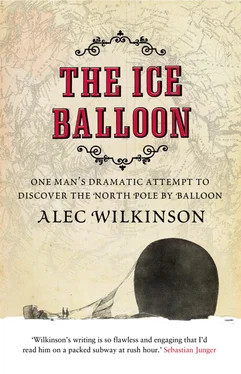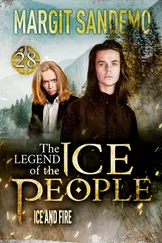The first man to try to reach the pole was Henry Hudson, in 1607, who believed that the most efficient way to travel to the East would be not to thread one’s way among icebound channels and bays of ice, but to go over the top of the world. Hudson was persuaded, as many geographers had been for centuries, that the ice formed only a species of blockade, and that past it was an open polar sea that possibly was temperate. On a voyage in 1610, pressing his crew to continue, he was overthrown. They put him and his son and a few sympathizers in a small boat, and they drifted off, through the bay that had been named for him, and were never heard from again.
After about 1847 most journeys to the Arctic were essentially search parties looking for the British explorer Sir John Franklin, who became the most famous man ever to be lost there. He was fifty-nine when he left England in May of 1845, having been sent to determine whether the part of Canadian coastline that was still unvisited, a little more than three hundred miles, completed the Northwest Passage. He had two ships, the Erebus and the Terror, which were last seen by a whaler in Baffin Bay, off Greenland, in late July. Franklin had been twice to the Arctic, and one of his voyages had been nearly legendary for its deprivations and suffering, but his third was inept. He sailed into the ice as if a gentleman on a foray into interesting territory, and disappeared.
Many historians think that Lady Franklin sent her husband to the Arctic in late middle age as a means of restoring prestige that had seeped from him (and her). Nevertheless she insisted that the government find him. Over thirty-one years, with public and private money, forty-two expeditions, the bulk of them from England but some from America, went looking for Franklin or for some explanation of why he hadn’t come back, then finally for relics of him. More people died in the search than on the expedition. Eventually it was learned from Eskimos and from diaries that were found, and from gravesites and artifacts, that his ships had been enclosed by ice, that he had died early in the confinement, the ships had been crushed, and that every one of his crew, roughly 128 in all, had died in the long retreat, some having practiced cannibalism.
This deeply unwelcome news was brought to England in 1854 by a Scottish explorer named John Rae, who was also a doctor. Eskimos told Rae, through an interpeter, that in the winter of 1850 some of their people had encountered about forty white men who were dragging a boat and some sledges. By means of gestures the white men explained that ice had destroyed their ship, and that they were hoping to reach territory where they could hunt deer. All of them were very thin. They bought seal meat from the Eskimos, camped overnight, and left the following day, heading east toward a river. Months later, by the river, the Eskimos found about thirty bodies and some graves. A day’s walk away they found five more bodies. Many of the bodies in both places had been mutilated. As best Rae could, he checked versions of the story against one another and found that they essentially agreed. In his report he wrote, “It is evident that our wretched countrymen had been driven to the last dread alternative as a means of sustaining life.” From the Eskimos Rae bought a gold watch, a surgeon’s knife, some silver spoons and forks, and a piece of silver plate that was engraved with Franklin’s initials.
Rae had meant his account to be private, but it was published in a newspaper, and it outraged Lady Franklin and pretty much the rest of the British, who refused to believe that their naval officers and sailors could have behaved dishonorably. Some people said that the Eskimos probably killed the Englishmen and made up the story. Charles Dickens, in a piece called “The Lost Arctic Voyagers,” published in two editions of his weekly magazine Household Words, wrote that Rae, while an unimpeachable source, had likely been misled by an interpreter who had been either unskilled or inclined, as were “ninety-nine interpreters out of a hundred, whether savage, half-savage, or wholly civilized,” to exaggerate so as to make himself seem more important.
Franklin was a sentimental figure but not a sympathetic one. He and his men had insisted on the rightness of British bearing and cold-weather cunning, and refused to enact any of the widely known practices of the Eskimos whose territories they were crossing. Apparently believing that their ships were invincible and that their tinned food would never run out, they had not included any accomplished hunters among them. The Arctic explorer and scholar Vilhjalmur Stefansson wrote of them in 1938, “One of the most baffling problems of Canadian exploration is how Sir John Franklin and his party of more than a hundred contrived to die to the last man, apparently from hunger and malnutrition, in a district where several hundred Eskimos had been living for generations, bringing up their children, and taking care of their aged.” People more favorably disposed to Franklin would respond that the meagerness of the Eskimo’s circumstances was proof that game was scarce in the Arctic and that even skillful hunters could not have fed as many men as were left; they had, so to speak, overwhelmed the territory.
Almost no nation managed more, or got beat up worse, in the Arctic than the British, the losses coming partly from a willfully romantic attitude and partly from pridefulness. A famously skilled British sledger of the nineteenth century, Sir Francis Leopold McClintock, who had looked for Franklin, gave a speech on sledging in which he described the British sledger undertaking a journey in the Arctic as characterized by a “strong sense of duty, and an equally strong determination to accomplish it—dauntless resolution and indomitable will; that useful compound of stubbornness and endurance which is so eminently British.” Before Franklin disappeared explorers frequently went to the Arctic and had terrible things happen to them, but often they returned and were heroes. After the Arctic erased Franklin and his ships and crew, the British were less keen about what benefits might be had from going there. (By the time the Northwest Passage was completed, in the late nineteenth century, it was useless from being so difficult to navigate. Furthermore, depending on how much ice there was and where it was concentrated, the passage wasn’t even in the same place every year.) Almost as a nation the British seemed to feel that the Arctic, having been paid the compliment of courtship, had not played fair.
The difference between the Arctic and the tropics, the other blanks on the period’s maps, is one of conception. Each drew a somewhat different type. Discoverers in the tropics were geographers, missionaries, seekers after mineral wealth, or pursuers of stories left in the archives of Spanish exploration about cities of gold. The formidable threats they faced—natives, disease, parasites, unholy heat, antagonistic creatures—were an alliance of resistance. To the European the place was a clotted mass of hazards, a closet in which disaster came at you in waves, whereas the Arctic was the open plain, the desert, the spaces where God and the wild spirits roamed.
In the mind of the eighteenth and nineteenth centuries, the Arctic was a region of severe—even sacred—purity, and the terms of life there were different from those of any more temperate place. In a year, to begin with, it had only one day and one night. Absence defined it. The palette of dangers was reduced to two: cold and starvation. No secondary antagonists such as poison arrows or insects or parasites or diseases intervened, unless in the case of scurvy, which was caused not by an agent native to the ground but by poor nutrition. (Fresh meat, it turned out, protected the Eskimos, but the Europeans relied mainly on lemon juice and the less effective lime juice.)
Читать дальше












